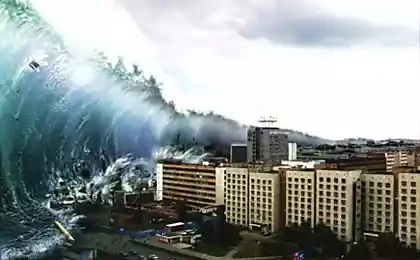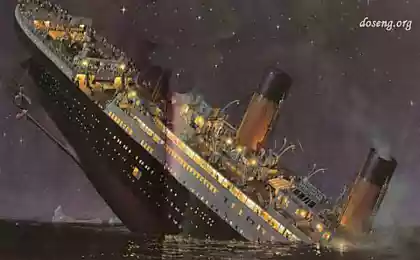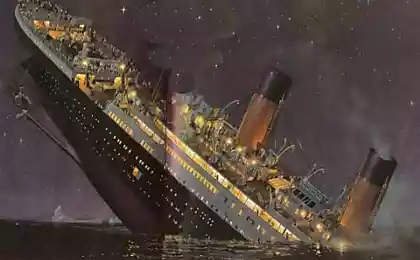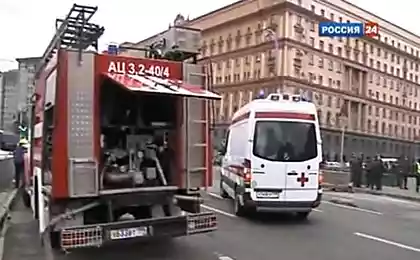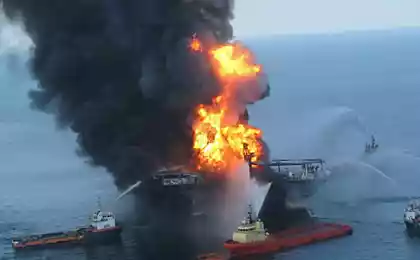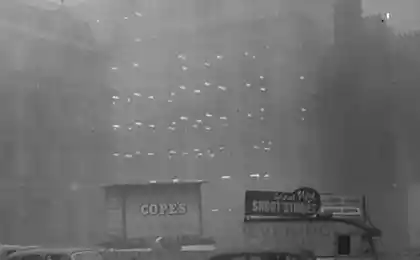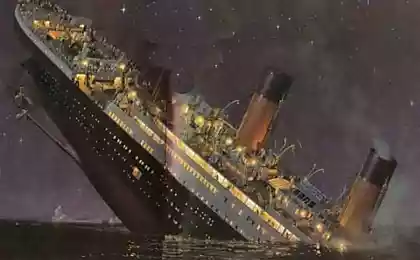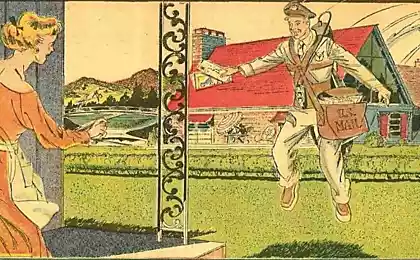1022
10 amazing disasters
1. Invasion of snakes in San Pierre
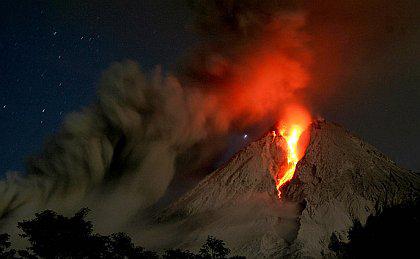
Volcanic activity "Bald Mountain" overlooking the city of Saint-Pierre, Martinique, was usually so insignificant that no one paid attention to the fresh steaming vents and shake the earth in April 1902 Meanwhile, in early May
Ash began a steady rain, and the air came the sickening smell of sulfur. As a result, more than a hundred pit viper vipers crawled out of their hiding places on the mountainside, as they become uninhabitable, and filled one of the neighborhoods of San Pierre, populated by mulattos. Poisonous 6-foot snake killed 50 people and innumerable animals before they were finally destroyed by huge street cats. But it was only beginning. The fifth of May, a huge landslide, which consists of boiling mud, splashed into the sea, causing a tsunami that killed several hundred people. Finally, three days later - May 8, volcano erupted, in which the number of murderous white-hot lava went straight into the city. Within three minutes, the city was completely razed to the ground. Of the total population of 30,000 people, only two survived.
2. Panic in the Church Shiloh Baptist Church

Two thousand people - mostly black, crowded into the church of Shiloh Baptist Church in Birmingham, Alabama, September 19, 1902, to hear the appeal of Booker T. Washington. Brick church was built recently. The front door was connected with the rise of chants for a flight of stairs, enclosed in brick. After the speech, Washington began a squabble over places of employment, and the word «fight» (fight) was adopted because of the word «fire» (fire). As if on cue, all the congregation jumped to their feet and rushed to the stairs. Those who got to her first, began to push back, and they began to fall. Other falls directly on them while screaming of bodies is not formed a pile height of 10 feet, completely blocked the passage. Attempts by Washington and church officials urge people to remain calm did not bear fruit, and they could only watch helplessly as their brothers and sisters, but mainly sisters or suffocated or were trampled to death. In fact, there was no fire, not even a fight, but 115 people died.
3. Large-scale flooding of molasses in Boston
Fifteenth January 1919, workers and residents of the northern district of Boston - mostly Irish and Italians took to the streets, enjoying the afternoon sun an unusually warm day. Suddenly, warning currently only short-lived low roar, a huge cast-iron tank Purity Distilling Company burst, and a great wave of raw black molasses two stories high, collapsed on the street Commercial Street, and poured on the surrounding areas of the port. Neither pedestrians nor horse rides could not overtake her. Two million gallons of molasses, intended for the production of rum, swallowed a lot of people - 21 people, among whom were men, women and children, were killed by asphyxiation, another 150 were injured. Feed destroyed several buildings and brought down the overpass elevated railway. Horses are not swallowed molasses, so much stuck in a sticky mass that police had to shoot them. Onlookers who came to look at all this chaos had to go in the molasses. On the way home they were separated sticky substance all over the city. A week in Boston smelled of molasses and brown port remained until the summer.
4. The gas tank explosion in Pittsburgh
The huge cylindrical gas tank - at that time the largest in the world, located in the heart of the industrial area of Pittsburgh, Pennsylvania, a leak. On the morning of November 14, 1927 a few repairmen began to look for her, using a blowtorch to open flame. Apparently, they found her about 10 hours - a reservoir containing 5 million. Cubic feet of natural gas, flew into the air like a balloon and exploded. Chunks of metal, some weighing more than 100 pounds, flew a great distance. A combined effect of air pressure and fire destroyed everything within a square mile. Twenty-eight people were killed and several hundred were wounded.
5. Demonstrations firefighters Gillingham
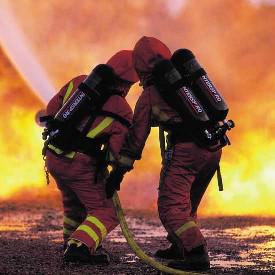
Each year, the city fire Gillingham, Kent, England, constructed of wood and canvas makeshift "home" to conduct demonstrations at the festival, held in Dzhillingemskom park. Also, every year, many applicants choose several local boys to participate in this presentation. Eleventh July 1929 nine boys aged 10 to 14 years and 6 fire, dressed in festive attire as if they were going to a wedding, climbed to the third floor "at home". According to the plan, firefighters had to light a smoke bomb on the first floor, save the "partying" with ropes and ladders, and then to set fire to an empty house, showing the fire hoses in action. However, by mistake, the first was lit a real fire. The spectators, assuming that the burning of the body that they see - a doll, joyfully cried and applauded, while the firemen outside directed streams of water on what they knew was a real disaster. All 15 people who are in the house were killed.
6. Facing the Empire State Building
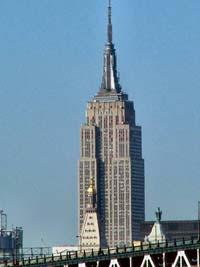
On Saturday morning, July 18, 1945, the veteran pilot took to the skies on a light bomber B-25 in Bedford, Massachusetts, and headed to New York City, New Jersey. On board was also attended by the co-pilot and a young sailor, who had to throw to New York. Standing fog has deteriorated visibility. An hour later, the people on the streets in the center of Manhattan suddenly heard rapidly increasing roar of the aircraft, and then watched in horror as suddenly popped out of the clouds bomber skirted skyscrapers and hit the wall Empire State Building. The wreckage of the aircraft and buildings hit by hail. On the 78th floor it formed a gaping hole. One of the engines of the aircraft struck seven walls, flew from the other side of the building, and another - a bullet flying through the elevator shaft, and cutting the cable, he has brought down the elevator straight to the basement. When the aircraft fuel tank exploded, flames engulfed six floors, and burning gasoline ran down the walls of the building. Fortunately, only a few offices worked on Sunday and killed all 11 people plus three passengers of the aircraft.
7. Developments in the Tunguska River
Thirtieth of June 1908 a large explosion occurred near the Stony Tunguska River in the area where is now Krasnoyarsk Krai of Russia. Perhaps the explosion was caused by a meteorite or comet fragment, reaching about 20 m. In diameter. Although it is believed that a meteorite (or comet) exploded before it hit the surface of the event say how about hitting. It is estimated that the power of the explosion was from 10 to 20 megatons of TNT, which is 1000 times more bomb dropped on Hiroshima, and similarly bombing Castle Bravo - the most powerful ever bombed the US.
The explosion felled 80 million. Trees in more than 2150 square meters. km. On satellite images are still visible traces of destruction.
8. The chain of explosions in Texas
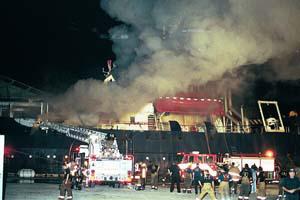
Fifteenth April 1947 freighter Grandcamp French moored in the port city of Texas, and it loaded 1,400 tons of fertilizers based on ammonium nitrate. At night in the hold Korablin fire broke out. By dawn, noticed thick black smoke, port management worried because only 700 feet from the port is the Monsanto chemical plant. As long as people stood in the dock and watched the tugs ready to pull the ship out to sea, when he was seized a ball of fire. For many it was the last thing they saw in their lives. A huge wall of fire parted to the side of the flaming wreckage, and a few minutes later a chemical plant exploded, killing and maiming hundreds of workers and observers who survived the initial explosion. A large part of the business district was destroyed, fires raged across the coastline, endangering standing nearby tanks with butane. Shortly after midnight, it exploded another ship, also transporting nitrate, and the chain was repeated. More than 500 people were killed and about 1,000 were seriously injured.
9. The mass poisoning in Basra
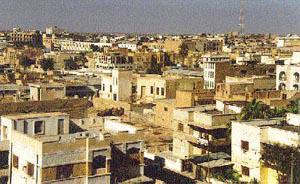
In September 1971, the Iraqi port city of Basra received a batch of seed weighing 90,000 tons. American barley and Mexican wheat treated with methylmercury in order to prevent damage, were painted in bright pink color indicating their lethal coating. Also printed on the bags were clear warnings, but only in English and Spanish. Before they could get to the farmers, the bags were stolen from the docks, and the seeds were sold to the starving population under the guise of food. The Iraqi government, embarrassed by their criminal negligence or for any other reasons, hushed up the story. But in less than two years, as one American journalist put forward evidence that 6530 cases of mercury poisoning have been associated with this hard-hitting story. Officials admitted only 459 deaths, but their total number is likely to reach more than 6000, including 100,000 people still suffering from the irreversible effects of poisoning, such as blindness, deafness and brain damage.
10. Mad elephants in the forest Chandka
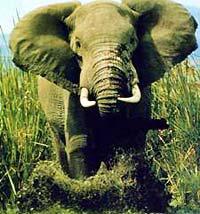
In the spring of 1972 Chandka forest in India, already suffering from drought, suffered a new blow hot wave. Local elephants, which usually do not cause any difficulties, so mad with the heat and lack of water that the villagers appealed to the authorities and said they would not run the risk of going out and cultivating their land. With the onset of summer, the situation has worsened. Tenth July herd of angry elephants swept through five villages, leaving behind widespread destruction and human death toll to 24.

Volcanic activity "Bald Mountain" overlooking the city of Saint-Pierre, Martinique, was usually so insignificant that no one paid attention to the fresh steaming vents and shake the earth in April 1902 Meanwhile, in early May
Ash began a steady rain, and the air came the sickening smell of sulfur. As a result, more than a hundred pit viper vipers crawled out of their hiding places on the mountainside, as they become uninhabitable, and filled one of the neighborhoods of San Pierre, populated by mulattos. Poisonous 6-foot snake killed 50 people and innumerable animals before they were finally destroyed by huge street cats. But it was only beginning. The fifth of May, a huge landslide, which consists of boiling mud, splashed into the sea, causing a tsunami that killed several hundred people. Finally, three days later - May 8, volcano erupted, in which the number of murderous white-hot lava went straight into the city. Within three minutes, the city was completely razed to the ground. Of the total population of 30,000 people, only two survived.
2. Panic in the Church Shiloh Baptist Church

Two thousand people - mostly black, crowded into the church of Shiloh Baptist Church in Birmingham, Alabama, September 19, 1902, to hear the appeal of Booker T. Washington. Brick church was built recently. The front door was connected with the rise of chants for a flight of stairs, enclosed in brick. After the speech, Washington began a squabble over places of employment, and the word «fight» (fight) was adopted because of the word «fire» (fire). As if on cue, all the congregation jumped to their feet and rushed to the stairs. Those who got to her first, began to push back, and they began to fall. Other falls directly on them while screaming of bodies is not formed a pile height of 10 feet, completely blocked the passage. Attempts by Washington and church officials urge people to remain calm did not bear fruit, and they could only watch helplessly as their brothers and sisters, but mainly sisters or suffocated or were trampled to death. In fact, there was no fire, not even a fight, but 115 people died.
3. Large-scale flooding of molasses in Boston
Fifteenth January 1919, workers and residents of the northern district of Boston - mostly Irish and Italians took to the streets, enjoying the afternoon sun an unusually warm day. Suddenly, warning currently only short-lived low roar, a huge cast-iron tank Purity Distilling Company burst, and a great wave of raw black molasses two stories high, collapsed on the street Commercial Street, and poured on the surrounding areas of the port. Neither pedestrians nor horse rides could not overtake her. Two million gallons of molasses, intended for the production of rum, swallowed a lot of people - 21 people, among whom were men, women and children, were killed by asphyxiation, another 150 were injured. Feed destroyed several buildings and brought down the overpass elevated railway. Horses are not swallowed molasses, so much stuck in a sticky mass that police had to shoot them. Onlookers who came to look at all this chaos had to go in the molasses. On the way home they were separated sticky substance all over the city. A week in Boston smelled of molasses and brown port remained until the summer.
4. The gas tank explosion in Pittsburgh
The huge cylindrical gas tank - at that time the largest in the world, located in the heart of the industrial area of Pittsburgh, Pennsylvania, a leak. On the morning of November 14, 1927 a few repairmen began to look for her, using a blowtorch to open flame. Apparently, they found her about 10 hours - a reservoir containing 5 million. Cubic feet of natural gas, flew into the air like a balloon and exploded. Chunks of metal, some weighing more than 100 pounds, flew a great distance. A combined effect of air pressure and fire destroyed everything within a square mile. Twenty-eight people were killed and several hundred were wounded.
5. Demonstrations firefighters Gillingham

Each year, the city fire Gillingham, Kent, England, constructed of wood and canvas makeshift "home" to conduct demonstrations at the festival, held in Dzhillingemskom park. Also, every year, many applicants choose several local boys to participate in this presentation. Eleventh July 1929 nine boys aged 10 to 14 years and 6 fire, dressed in festive attire as if they were going to a wedding, climbed to the third floor "at home". According to the plan, firefighters had to light a smoke bomb on the first floor, save the "partying" with ropes and ladders, and then to set fire to an empty house, showing the fire hoses in action. However, by mistake, the first was lit a real fire. The spectators, assuming that the burning of the body that they see - a doll, joyfully cried and applauded, while the firemen outside directed streams of water on what they knew was a real disaster. All 15 people who are in the house were killed.
6. Facing the Empire State Building

On Saturday morning, July 18, 1945, the veteran pilot took to the skies on a light bomber B-25 in Bedford, Massachusetts, and headed to New York City, New Jersey. On board was also attended by the co-pilot and a young sailor, who had to throw to New York. Standing fog has deteriorated visibility. An hour later, the people on the streets in the center of Manhattan suddenly heard rapidly increasing roar of the aircraft, and then watched in horror as suddenly popped out of the clouds bomber skirted skyscrapers and hit the wall Empire State Building. The wreckage of the aircraft and buildings hit by hail. On the 78th floor it formed a gaping hole. One of the engines of the aircraft struck seven walls, flew from the other side of the building, and another - a bullet flying through the elevator shaft, and cutting the cable, he has brought down the elevator straight to the basement. When the aircraft fuel tank exploded, flames engulfed six floors, and burning gasoline ran down the walls of the building. Fortunately, only a few offices worked on Sunday and killed all 11 people plus three passengers of the aircraft.
7. Developments in the Tunguska River
Thirtieth of June 1908 a large explosion occurred near the Stony Tunguska River in the area where is now Krasnoyarsk Krai of Russia. Perhaps the explosion was caused by a meteorite or comet fragment, reaching about 20 m. In diameter. Although it is believed that a meteorite (or comet) exploded before it hit the surface of the event say how about hitting. It is estimated that the power of the explosion was from 10 to 20 megatons of TNT, which is 1000 times more bomb dropped on Hiroshima, and similarly bombing Castle Bravo - the most powerful ever bombed the US.
The explosion felled 80 million. Trees in more than 2150 square meters. km. On satellite images are still visible traces of destruction.
8. The chain of explosions in Texas

Fifteenth April 1947 freighter Grandcamp French moored in the port city of Texas, and it loaded 1,400 tons of fertilizers based on ammonium nitrate. At night in the hold Korablin fire broke out. By dawn, noticed thick black smoke, port management worried because only 700 feet from the port is the Monsanto chemical plant. As long as people stood in the dock and watched the tugs ready to pull the ship out to sea, when he was seized a ball of fire. For many it was the last thing they saw in their lives. A huge wall of fire parted to the side of the flaming wreckage, and a few minutes later a chemical plant exploded, killing and maiming hundreds of workers and observers who survived the initial explosion. A large part of the business district was destroyed, fires raged across the coastline, endangering standing nearby tanks with butane. Shortly after midnight, it exploded another ship, also transporting nitrate, and the chain was repeated. More than 500 people were killed and about 1,000 were seriously injured.
9. The mass poisoning in Basra

In September 1971, the Iraqi port city of Basra received a batch of seed weighing 90,000 tons. American barley and Mexican wheat treated with methylmercury in order to prevent damage, were painted in bright pink color indicating their lethal coating. Also printed on the bags were clear warnings, but only in English and Spanish. Before they could get to the farmers, the bags were stolen from the docks, and the seeds were sold to the starving population under the guise of food. The Iraqi government, embarrassed by their criminal negligence or for any other reasons, hushed up the story. But in less than two years, as one American journalist put forward evidence that 6530 cases of mercury poisoning have been associated with this hard-hitting story. Officials admitted only 459 deaths, but their total number is likely to reach more than 6000, including 100,000 people still suffering from the irreversible effects of poisoning, such as blindness, deafness and brain damage.
10. Mad elephants in the forest Chandka

In the spring of 1972 Chandka forest in India, already suffering from drought, suffered a new blow hot wave. Local elephants, which usually do not cause any difficulties, so mad with the heat and lack of water that the villagers appealed to the authorities and said they would not run the risk of going out and cultivating their land. With the onset of summer, the situation has worsened. Tenth July herd of angry elephants swept through five villages, leaving behind widespread destruction and human death toll to 24.

